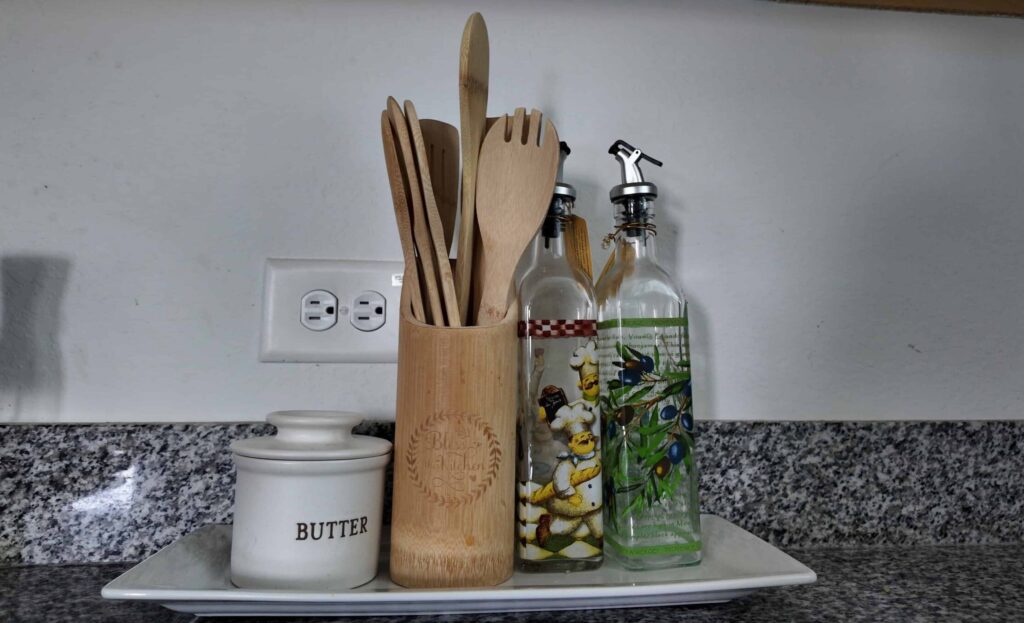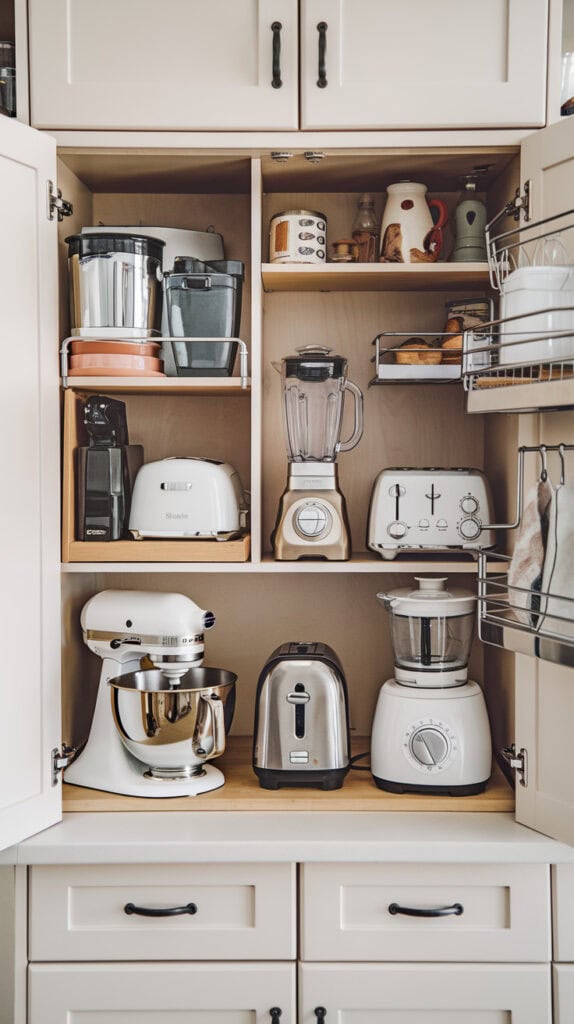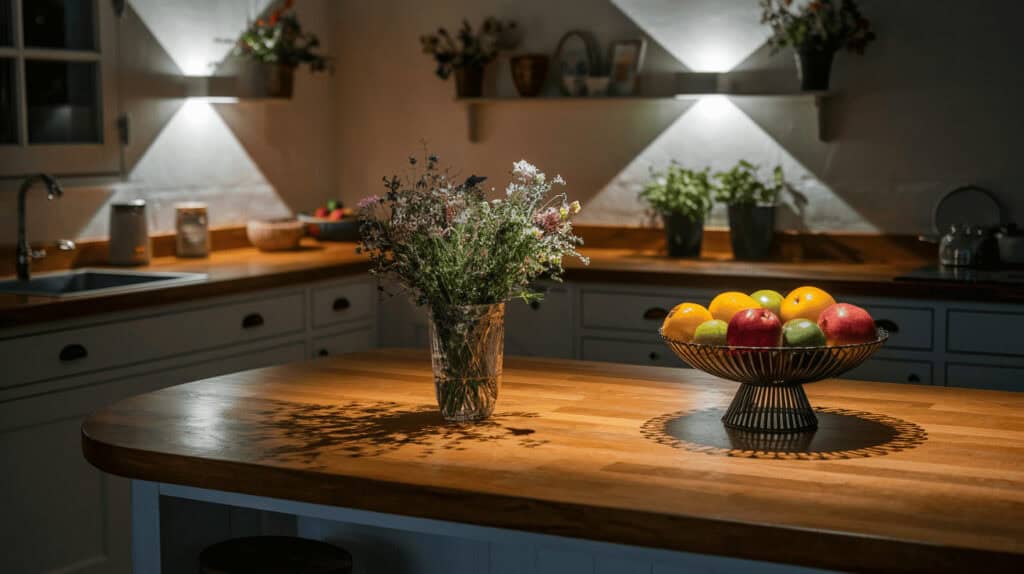Goodbye Clutter: 9 Kitchen Organization Hacks
Want a full breakdown? Check out my mega list: 53 Genius Kitchen Organization Hacks
Ever spent several minutes hunting for that one measuring spoon while your sauce burns? Yeah, me too. After years of battling cluttered countertops and cabinets that looked like they’d been hit by a tornado, I finally cracked the code to kitchen organization that sticks.
Why Smart Kitchen Organization Matters
A well-organized kitchen turns daily cooking from “ugh, not again” into something you might actually enjoy.
When my kitchen makes sense, I waste way less time searching for stuff. Think about it. How many minutes have you lost digging through drawers for a spatula or hunting for that jar of cinnamon you know you bought? Those minutes add up fast.
Smart organization makes even tiny kitchens work better. I used to think I needed more space, but really, I just needed to use what I had more wisely. By putting things where they make sense: think coffee mugs near the coffee maker, pots close to the stove, I created a kitchen that flows with how I cook.
The benefits go beyond convenience:
- Reduce food waste by keeping ingredients visible
- Save money by avoiding duplicate purchases
- Cut down on daily cooking frustration
- Create a more enjoyable cooking experience
Identifying Problem Areas
My kitchen’s trouble spots became obvious once I started paying attention to where I got frustrated while cooking. Common problems include:
- Crowded counters that leave no workspace for meal prep
- Deep cabinets where items disappear into the abyss
- Awkward corners where cabinet space goes unused
- Messy drawers with utensils jumbled together
- Wasted vertical space on walls and inside cabinets
That moment when you’re holding a hot pan and have nowhere to put it down? That screams “I need more accessible counter space.” Or when you’re frantically searching through a drawer for a measuring spoon? That says “utensil organization needs work.”
9 Kitchen Organization Hacks That Actually Make Sense
1. Understanding Work Zones
Think of your kitchen as a professional workspace with distinct areas. I find thinking about my kitchen in five main zones makes organization much simpler:
- Prep zone – Cutting boards, knives, mixing bowls
- Cooking zone – Pots, pans, cooking utensils
- Cleaning zone – Dish soap, sponges, drying rack
- Storage zone – Pantry, fridge, cabinets
- Serving zone – Plates, cups, silverware
Storing items close to where I use them means I get way less annoyed while cooking. Keeping the classic “kitchen triangle” (sink, stove, fridge) easily accessible reduces wasted movement and frustration.
2. Pantry Transformation: More Than Just Shelving
Your pantry isn’t just storage, it’s your meal planning headquarters. Group items by how you actually cook:
- Baking supplies together
- Quick-meal basics in one area
- Breakfast items in their own spot
Tips:
- Use clear, airtight containers for visibility
- Place frequently used items at eye level
- Invest in stackable solutions that maximize vertical space

My favorite investments include:
- Airtight containers for flour, sugar, and grains
- Stackable bins that doubled my tiny pantry’s capacity
- Turntables for small items like spice jars
- Clip-on basket organizers for cabinet doors
For bulky items like chips and snacks, clear bins work great. They keep everything corralled while still fitting odd-shaped packages.
3. Cabinet Makeover: No More Black Hole Syndrome
I found upper and lower cabinets require different strategies:
Upper Cabinets:
- Group similar items (glasses near the fridge, plates near the dishwasher)
- Use shelf risers to create extra levels
- Keep everyday items easily accessible
Lower Cabinets:
- Install pull-out drawers for better access
- Use vertical organizers for pot lids and baking sheets
- Group food storage containers by size
Under the sink was formerly a black hole of cleaning supplies. Now I use bins to group similar items together. Sponges, pods, and smaller bottles go in baskets that slide in and out, making everything easy to see at a glance.
4. Drawer Organization That Works
- Group similar tools together
- Use vertical storage containers
- Implement adjustable dividers
- Keep most-used items near the stove
My utensil drawers used to be chaos. Spatulas tangled with whisks, measuring spoons buried under pizza cutters—it was a mess. Now I group similar tools together:
- Cooking utensils (spatulas, wooden spoons, tongs)
- Baking tools (measuring cups, pastry brushes)
- Specialty items (garlic press, zester)
Adjustable dividers are awesome as well. They create customized sections that fit my drawers perfectly and adapt when my needs change.
5. Countertop Organization Without Clutter
Not everything needs to live on your counter. Ask yourself: “Do I use this at least three times a week?”
Smart Countertop Strategies:
- Use vertical storage solutions
- Group essentials in attractive containers
- Keep only daily-use items out, like oils, salt, and pepper near the stove

My food processor used to take up valuable space until I realized I only use it twice a month. Now it lives in a cabinet, and I don’t miss it at all.
6. Refrigerator and Freezer Organization
Transform your fridge from a food graveyard to an organized marvel:
- Create zones: ready-to-eat foods, dairy, meats, produce
- Implement a “first in, first out” rotation
- Label containers with purchase or prep dates
- Use clear bins to prevent small items from getting lost
If you do a lot of bulk purchases, consider a chest freezer for extra storage. I keep one in my garage to hold frozen veggies, meat, and bulk meal preps.
7. Strategic Meal Planning Station
A dedicated meal planning area can transform how you approach cooking:
- Install a small whiteboard or calendar for weekly meal planning
- Keep favorite cookbooks or a tablet stand nearby
- Store meal planning essentials like measuring tools close
A well-designed meal planning station helps eliminate the daily “what’s for dinner?” stress.
8. Small Appliance Storage Solutions
Small appliances often create the biggest organizational challenges:
- Categorize appliances by frequency of use
- Store infrequently used items in higher cabinets
- Use pull-out shelves for heavier items
- Keep appliance attachments in labeled bins

9. Maintaining Your Organized Kitchen
Keeping a kitchen organized isn’t a one-time task, it’s a daily habit. Spending just a few minutes each day on maintenance saves hours of frustration later.
Daily 10-Minute Reset:
- Return items to their homes
- Wipe down surfaces
- Prepare for the next day
After dinner, I put things back, wipe counters, and make sure the sink is empty. This tiny habit means I wake up to a clean slate.
Weekly Maintenance Checks:
- Glance through the fridge for expiring items
- Wipe down sticky spots in cabinets
- Ensure drawers stay organized

Your New Kitchen: From Mess to Yes!
Start small if you’re feeling stuck. Maybe tackle that crazy utensil drawer this weekend? Just one little win will get you pumped to do more. The first time you open a drawer and everything is where it should be? Pure kitchen magic.
The best part isn’t how good your kitchen looks, it’s how good it feels to cook there. Your kitchen should fit you, not some magazine ideal. If keeping your coffee stuff by the fridge makes mornings easier, who cares about the “rules”?
